The Best CFexpress Memory Cards in 2023
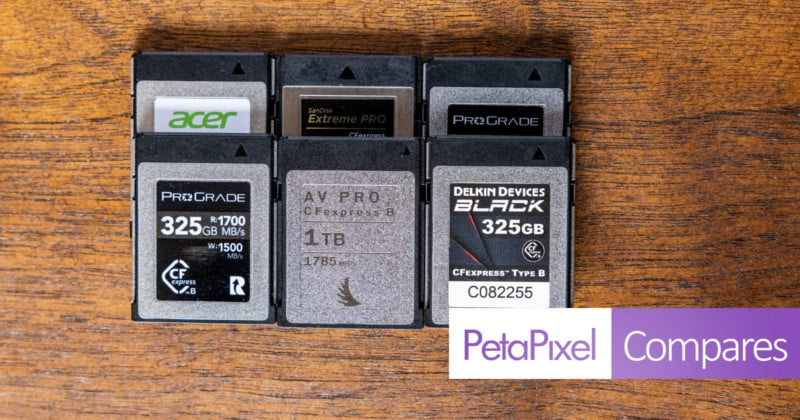
CFexpress has finally come into its own and multiple companies are now producing a wide variety of capacities at a range of prices. But with so many choices, which one should you buy?
Updated 2/16/2023: We have made significant updates to this guide, including the addition of multiple new memory cards. Blackmagic updated its disk speed reader, so all the cards were re-run in order to maintain consistency and accuracy. Additionally, we changed our process for burst photo capture by increasing the data load on the cards. We also have removed the objective video portion of our test — but retained our subjective experience notes — while we determine a better way to provide that data to you.
We have also added a new section that discusses pricing and what card is the best value for its performance.
CFexpress Type B is, right now, the most common “next generation” memory card format and has all but totally won out over the SD Association’s flawed SD Express format despite its lofty promises. While CFexpress Type A is also coming into its own, only Sony is using the format in its mirrorless cameras and at the time of publication, only three companies are producing that card format.
When more are available, this guide will grow to include CFexpress Type A as well but, for now, the two options from ProGrade Digital and Sony perform basically identically. PetaPixel has not received Delkin’s option to test.
Every other camera company besides Sony that has updated to the latest and greatest memory card format is using Type B, and as such there are a lot more options in the marketplace.
But all that performance comes at a literal cost: CFexpress Type B cards can get pretty expensive. To save you the wallet-ache of making a bad decision, we’ve created a rigorous multi-stage test to put CFexpress cards through the wringer and help you make the best buying decisions.
Below is a list of all the CFexpress Type B cards included in our testing:
- SanDisk Extreme Pro
- ProGrade Digital Gold (Old version, new version has not arrived for testing)
- ProGrade Digital Cobalt
- Acer
- Angelbird AV PRO
- Delkin Devices Black Series
- Sony TOUGH
- Exascend Nitro
- Pro Master Pro Velocity Cine
- OWC Atlas Pro
- OWC Atlas Pro Ultra
- Lexar Diamond Series
- Nexstorage B1 Pro
- Pergear Ultra
- SanDisk Pro Cine
PetaPixel will update these results periodically as we obtain more cards, so make sure to bookmark this story and check back when you’re ready to make a purchase.
The Tests
To evaluate which cards performed best, we subjected each to a series of tests. In the case where a card manufacturer also supplies a card reader, we used paired those products together. If a company did not provide PetaPixel with a reader, tests were performed on the ProGrade Digital CFexpress Type B and SD UHS-II dual card reader.
First, we tested the cards with Blackmagic Speed Test to get numbers for the average peak read and write speeds that can be expected when loading and unloading data to a computer. We then filled the cards at more than three-quarters of each of their capacities and tested the speed again to make sure that adding data to the cards does not affect performance. These tests provide us with a baseline level of performance to expect.
The second test goes beyond peak speeds and looks at sustained speeds, which are a lot harder for memory card manufacturers to hit consistently high numbers. These tests are performed with HD Tune, one of a few industry-standard benchmarks for measuring memory performance, and are shown as an average of read and write speed performance, referred to as transfer speed.
The third and final test is the most relevant for photographers. We tested how many seconds we could fire a Canon R5 at maximum framerate and resolution before we hit the limits of the buffer. This means we asked the camera to record both RAW and the highest quality JPEG and do so firing at the maximum 20 frames per second with the electronic shutter. This test was performed three times and the results were averaged.
The Results
Disk Speed Tests
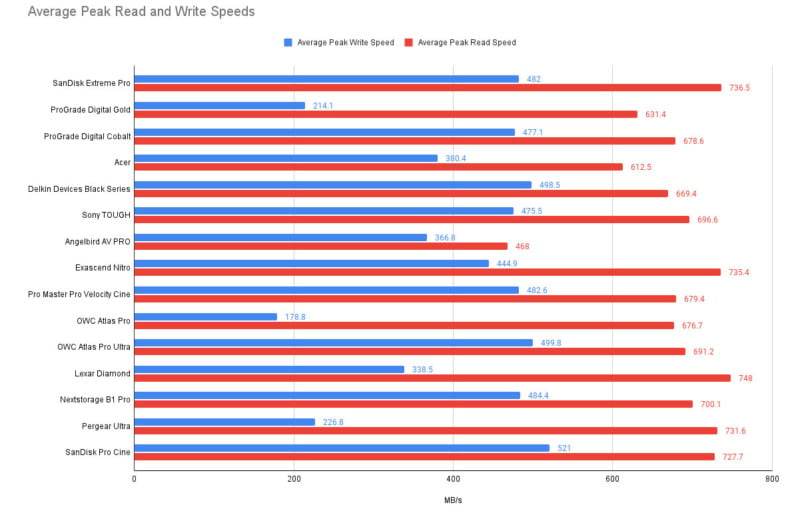
In this test, higher is better. Top performers here go to SanDisk, Exascend, and Lexar. While the Pergear Ultra kept up on the read speed front, it wasn’t very impressive when it came to write speed. Acer, OWC’s Atlas Pro, Angelbird, and Prograde’s Gold series cards performed the worst here, but with speeds that are by no means “bad.”
Sustained Disk Speed Tests
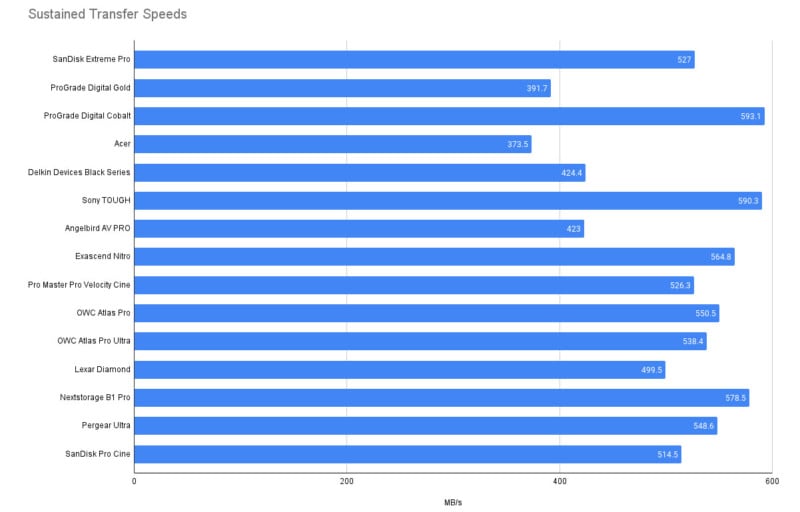
In this test, higher is better and several brands stood out: SanDisk Extreme Pro, ProGrade Digital Cobalt, Sony TOUGH, Lexar, Exascend Nitro, Pergear Ultra, Nexstorage B1 Pro, and Delkin Black Series. ProGrade’s Cobalt card tested the highest sustained speed, with Sony’s TOUGH card close behind. Acer scored the worst here as the divide between its best and worst transfer speeds during the benchmark was very wide.
Burst Photo Test
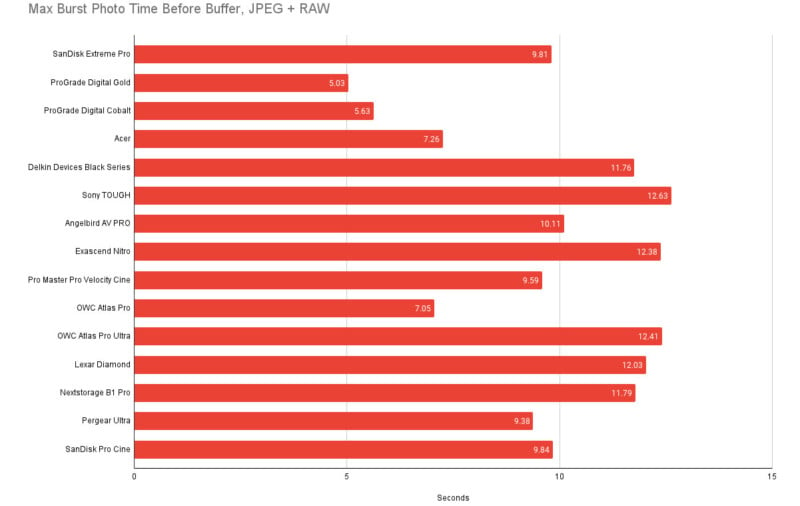
In this test, higher is better. This was perhaps the most telling test, as it let us know not only how well a card was able to take data as fast as a camera’s buffer could fill, but it also told us how well the cards were able to bounce back once that buffer limit was reached. As a note, when writing to maximum sized JPEG and RAW, the buffer of the R5 is 45 frames. Given the 20 frame per second maximum of the R5, the worst cards were able to write about 100 images while the best were able to write more than 240 — quite the gap.
The top performing cards in this test were the OWC Atlas Pro Ultra, Sony TOUGH, Exascend Nitro, Nexstorage B1 Pro, and Lexar Diamond. Several others like the Delkin Black Series and Angelbird AV Pro were close behind, while beyond that the dropoff was rather steep. Of note, both ProGrade Digital cards we tested performed particularly poorly here not only with their maximum recording time, but also in their bounce-back time. After hitting the buffer limit, it took both cards an excess of 15 seconds for the camera’s buffer to fully recover, while the higher-performing cards we tested bounced back in under five seconds — sometimes as quickly as two or three seconds.
Insights, Takeaways, and Recommendations
This might be a good time to mention why the speeds we saw in testing are nowhere near the speeds any of the companies put on the packaging. Just about every CFexpress card promises read speeds at or above 1,700 MB/s, but the best we saw didn’t even get to 900 MB/s peak speeds and sustained speeds were much lower.
This is because those peak speeds were most likely obtained in laboratory environments with the SSD bus plugged directly into a host PC. While this will give the absolute maximum performance the silicon is able to produce, it’s also not anything close to a real-world situation. Our tests aim to give you a better idea of what to actually expect.
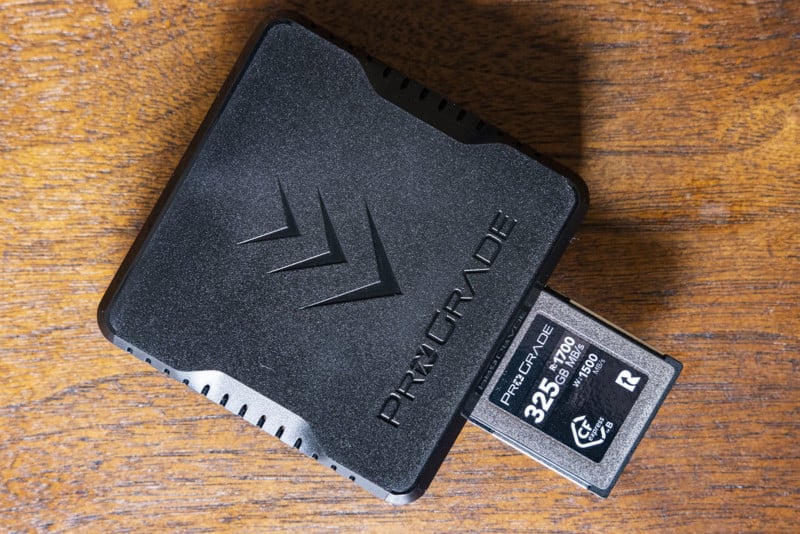
Video Performance
Note: While this section’s information is no longer presented in the charts above, it is still relevant and thus we have kept it here for reference, as the information is still accurate.
Let’s get to the good news: every card we tested worked to our satisfaction when it comes to recording high-resolution video data. Every card, regardless of the speeds promised, was able to ingest 8K RAW video footage until the camera overheated, which means it’s highly unlikely that anyone would run into any issues with the cards when shooting in the field — the camera will fail before the card does.
Even if a card doesn’t even come close to the promised peak read or write speeds seen on the side of the box (which none of them did, by the way), it doesn’t matter. For video, Acer, which promised the least when it comes to read and write speeds, performed identically to Angelbird which promised the most.
A majority of the cards we tested were able to sustain more than 400 MB/s transfer speeds, with only ProGrade Digital’s Gold series and Acer falling below that threshold. The only two cards we tested that has the Compact Flash Association’s VPG400 certification — which requires 400 MB/s sustained speeds — were Lexar’s Diamond and Exascend’s Nitro cards, although despite this they aren’t the ones holding the highest sustained transfer speeds: that goes to Prograde’s Cobalt line and Sony’s TOUGH cards. So while AngelBird promises some seriously high sustained speeds on its website and in marketing materials, we weren’t able to replicate them using industry-standard software.
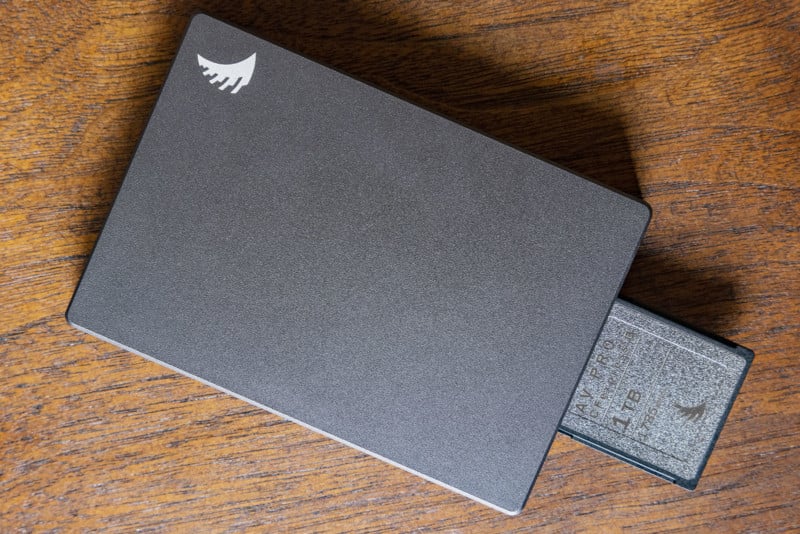
That said, there may be a reason for that. Angelbird is extremely nitpicky about which cards are designed for which cameras which could mean that it does have some kind of special tuning to work with cameras better than with computer software. This seems like a stretch, but we have no way to tell.
For the most part, these cards were all pretty consistent in their performance during our benchmarking with the exception of Acer and Atlas Pro, both of which were a lot more frenetic in how much they jumped from high speeds to low speeds during testing, which gives us pause recommending either for video workflows.
Photo Performance
Some brands separated themselves from the pack in the photography section, however, and there are clear winners and losers when it comes to long periods of burst photo performance.
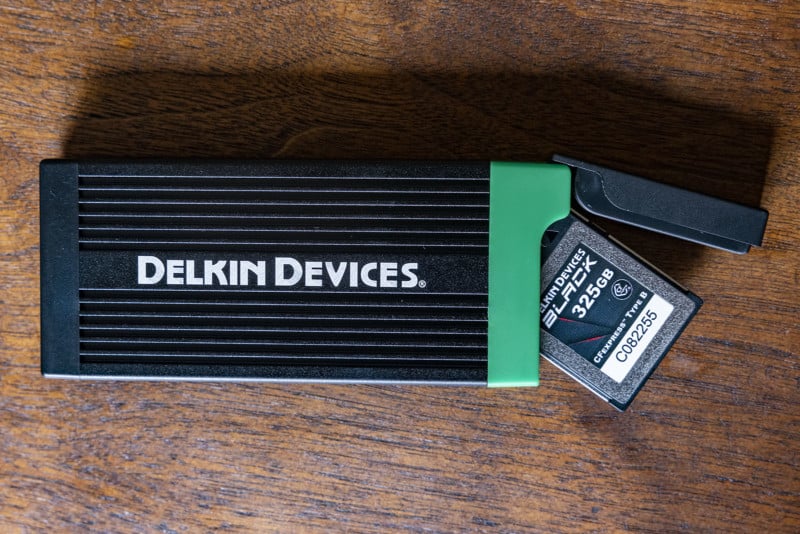
Sony, OWC, Lexar, and Exascend all performed within a margin of error, while Nextstorage and Delkin were right on their tails. All six of these cards were able to fire at least 200 frames without dropping below the maximum 20 frames per second that the Canon R5 shoots and were very quick to bounce back. It is highly unlikely that a photographer would be holding down the shutter for that lond uninterrupted, but even if they did, these cards would be able to support quickly firing at that pace again after only a short few second break.
On the bottom end, however, not only were cards like both of ProGrade’s options, Acer, and the lower-end OWC Atlas not able to record for nearly as many consecutive frames, some weren’t able to recover fast enough to make them even worth using in high-stress situations like sports or events.
If you are strictly a photographer who needs the ultimate burst photo performance and can’t risk missing a shot, rely on Sony TOUGH, OWC Atlas Pro Ultra, Lexar Diamond, or Exascend Nitro first and foremost, but don’t be afraid to pick up a Delkin Devices Black Series or the Nexstorage Pro B1 Pro either. If any of these are on sale, don’t hesitate to pick them up.
The Best Options
Overall, of the cards that we tested, we recommend going with Sony’s TOUGH, Lexar’s Diamond Series, Exascend’s Nitro, SanDisk’s Extreme Pro (which performed so similarly to the SanDisk Pro Cine that we aren’t sure there really is even a difference), the Nexstorage B1 Pro, or Delkin’s Black Series.
These cards posted excellent performance in both video and photo testing as well as our computer-based benchmarking. You will be safe to pick up any of these, so shop for what is on sale — unless you care about ultimate burst photo performance, in which case we recommend Sony above all others.
I will say that while the Exascend Nitro memory card performed very well, the company’s 20Gbps card reader is super loud. While it doesn’t seem to have any bearing on performance, the reader itself has active cooling that creates a whopping 65 decibels of noise. If any card is plugged into the reader, it screeches at a high pitch that is incredibly annoying. No other reader we tested does this, and it didn’t perform any better than our ProGrade Digital standard testing reader in exchange for all that racket.
When we brought this up, Exascend told us that the card reader is purpose-designed to deliver transfer speeds of up to 20 Gb/s, making its built-in fan a necessity for effective cooling. However, to realize that speed, it requires that the user’s computer system also supports USB 3.2 Gen 2 x2 transfers. That’s not common right now, but the company says the design future-proofs the reader.
Of all the available cards, if capacity is your biggest concern, Angelbird is probably the best bet since it currently is the only brand to offer a whopping 4TB in a single card.
The Best Value CFexpress Type B Card in 2023
Before we get to our best overall pick, it is important to consider that not everyone is going to need the best-performing memory card in order to be happy. Often, the best card is the one that balances good enough performance with a low asking price.
From that perspective, Pergear’s card is probably the best pure value of all the options. Sure, it doesn’t really impress with its write speed, but its sustained transfer speed hangs with some of the best we tested and it was able to hit a little more than the average when it came to burst photo capture. So while it’s not the best at anything, it’s certainly not the worst either, and it’s really hard to argue with the $379 price for 1TB capacity.
One thing that is also worth considering is warranty and support. For example, Pergear’s card promises a five-year limited warranty, but we won’t know for several years how viable that is since the cards are so new. At the time of publication, Pergear also doesn’t list the details of a five-year warranty, only its one-year warranty.
Always check on the warranty details before making an expensive purchase like a CFexpress card to make sure you feel comfortable relying on it to hold your photos and videos.
The Best CFexpress Type B Card in 2023
If you are looking to buy the best card with the most reliable performance, then we recommend the Sony TOUGH card. While it does not post the highest marks in all categories, it brought the most consistent read and write peaks and some of the best sustained performance among all the cards. It is also supported by a five-year limited warranty.
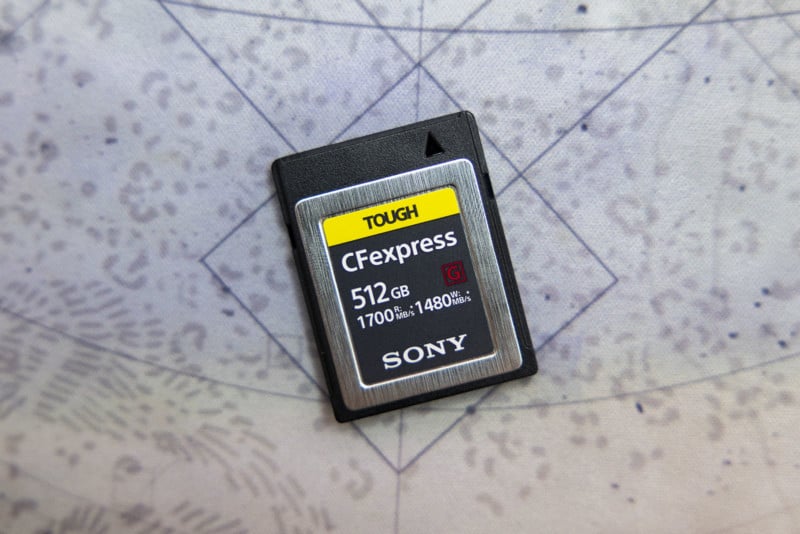
PetaPixel’s Choice: Sony TOUGH CFexpress Type B memory card.